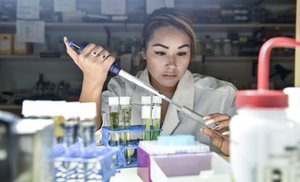From the laboratory to the classroom, from the field to the greenhouse, West Virginia State University conducts research that is highly applicable and responsive to agricultural, environmental and societal needs, while providing hands-on student learning opportunities.
As a Land-Grant Institution, we are committed to conducting research for the betterment of West Virginia. With our Agricultural & Environmental Research Station (AERS), part of the Gus R. Douglass Land-Grant Institute, we maintain a competitive portfolio of research programs driven by national and state agendas. We are committed to developing knowledge and engaging in technology transfer and economic development activities beneficial to West Virginia and all our constituents.
From on-campus labs, field plots and greenhouses to our research farm site in Mason County, West Virginia, AERS is an ever-increasing presence in agricultural and environmental research in the Mountain State.
Explore our portfolio, which focuses on Aquaculture, Bioenergy and Environmental Biotechnology, Environmental Microbiology and Biotechnology, Food Science, Specialty Crop Breeding & Production, Urban Forestry & Natural Resource Management and Vegetable Genomics & Plant Breeding:
Aquaculture
We are focused on improving aquaculture production efficiency of cool-water (rainbow trout) and warm-water (channel catfish) fish grown and marketed in West Virginia.
Bioenergy and Environmental Biotechnology
In nature, plant oils represent one of the most energy-rich sources of renewable hydrocarbons, and are stored in the form of triacylglycerols (TAGs) in oilseeds. These TAGs are used as alternative feedstock for biodiesel production.
Environmental Microbiology & Biotechnology
We are interested in understanding how microbes control environmental processes and how they can be used in biotechnology, particularly bioenergy generation.
Food Science
We explore agricultural food products produced in West Virginia and develop “value-added” products from raw agricultural goods.
Specialty Crop Breeding & Production
This program has the goal of developing pest resistant fresh market tomato varieties with superior organoleptic traits for protected culture production (greenhouse and/or high tunnel).
Urban Forestry & Natural Resource Management
Growing urban and rural development and the continuing exploration of natural resources adversely impact natural soil and water resources. Moreover, the region’s inherently acidic and nutrient-poor soils are in need of improvement in order to increase agronomic productivity and the contribution of agriculture to the local economy.
Vegetable Genomics & Plant Breeding
We explore cutting-edge sequencing tools to identify genes and DNA polymorphisms for use in plant breeding.
WVSU Energy and Environmental Science Institute
The mission of the West Virginia State University Energy and Environmental Science Institute (WVSUEESI) is to conduct basic and applied interdisciplinary research in energy and environmental science to generate technology and knowledge.

Reasonable accommodations will be made to provide this content into reasonable alternate accessible formats upon request. Please contact our offices at (304) 204-4356 or email us.
Our Team




